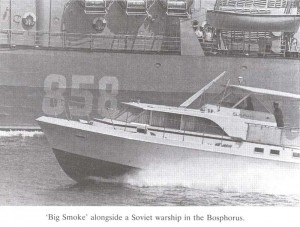The Task Force

(Photo of Big Smoke, a motor yacht used by the U.S. Navy’s Task Force 157, for intelligence collection operations in the Mediterranean. Photo from Jeffrey Richelson, “Task Force 157: The U.S. Navy’s Secret Intelligence Service, 1966-77,” Intelligence and National Security 11 (1996), 118; it is used because I had to buy the article for $34 bucks and I only spent the money because..well, you now.)
It is five-thirty at the farm. Time to get back up North and attend a meeting which will have the participants furtively looking at Accuweather on their mobile devices, waiting for the snow to come it. It is my fault. I declared Winter over last week, and now we are all going to pay for my folly.
We have had some fun with Big Smoke, and I wanted to pay tribute to him now that he has gone on to the Big Task Force in the sky. He told me those two tales of long ago: during the Occupation of Japan, and in the Cote A’Zure, which now seem as distant as the lunar surface.
You have seen the slide show of the modern marvels that are Hiroshima and Nagasaki today, juxtaposed with the images of the former Arsenal of Democracy, my home-town of Detroit, Michigan.
As I said, like going to the moon. Now that Mac Showers and Big Smoke are gone, there are many holes in the story. Mac trusted me not to disclose some of the stories he told me. There are a couple of them that are quite hysterical, but could damage reputations even this long after the fact, and that is something that he wouldn’t do and neither will I, though I will continue to chuckle about one the resulted in the future Admiral hiding under a piano for the night.
Mac served with Big Smoke in London on the staff of CINCNELM, though relations would have been proper and distant between Commissioned Officer and Enlisted member.
He certainly knew him later, and crossed paths many times in the course of their subsequent careers. Big Smoke got his commission, in the mid 1950s, though I do not know the date with any precision. He tried to continue what was considered a balanced career path of Fleet and Shore commands, but it did not work out that way.
His time in counter-intelligence and law enforcement made him a rarity in the officer corps. While the Office of Naval Intelligence was entrusted with command of the Naval Investigative Service (forerunner of today’s television-ready NCIS) the backbone of the agent force were career civilians. As an Intelligence Officer, one tour with the NIS was not necessarily a career ender, though two would have people looking at you funny, unless the second was as the Commander.
I have written extensively about Mac’s experience with that special breed of Naval Officer like code-breaker Joe Rochefort, or Mac’s good friend Rufus Taylor, who like Eddie Layton and Marine “Red” Lasswell were ordered to study the Japanese language. Most of them were not intelligence officers; like Mac they were from the Deck community.
It was only after the war that the requirements for Air Intelligence personnel and cryptologists created a surge in numbers in the restricted line intelligence communities. There was no room in the Cold War Navy for language specialists of that order; the soviets would hardly have permitted that. The art of spying- or let’s call it “close observation” languished except for the small cadre assigned to Attaché duty.
By the time of the Cuban Missile Crisis, it was just about moribund. The only officer who was actively engaged seemed to be Hal Feeny, the Base Intelligence Officer at GTMO.
In the chaotic aftermath of the failed invasion at the Bay of Pigs, the Navy was blasted by AG Bobby Kennedy for its poor performance. His acid inquiry was about why there had been no systematic debriefing of Cuban workers on the base, who were able to come and go through the wire and travel freely in the newly Socialist island.
The man picked to travel to the island to establish a human intelligence capability was Tom Duval, who got right to work, puffing on one of his trademark stogies. The result was Task Force 157, which was either a low-budget scheme to support the Fleet, or a crazy aunt that became a means for the IC to go a little nuts.
I swear, we will end this naval gazing tomorrow, and get to the carpet-bombing of the capital that has come with Sequestration. Here is how Big Smoke’s next career started, from SECNAV, circa mid-1960s:

Copyright 2013 Vic Socotra
www.vicsocotra.com
